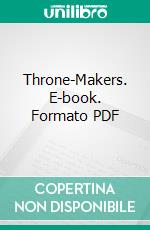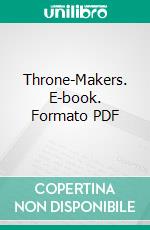Throne-Makers. E-book. Formato PDF - 9788832516784
di William Roscoe Thayer
edito da IONLINESHOPPING.COM , 2019
Formato: PDF - Protezione: nessuna
PREFACE
Since 1789 every European people has been busy making a throne, or seat of government and authority, from which its ruler might preside. These thrones have been of many patterns, to correspond to the diversity in tastes of races, parties, and times. Often, the business of destroying seems to have left no leisure for building. In England alone have men learned how to remodel a throne without disturbing its occupant; as we in America raise or move large houses without interrupting the daily life of the families who dwell in them.
To portray the personality of some of the conspicuous Throne-Makers of the century is the purpose of the following studies. I have wished to show just enough of the condition of the countries under review to enable the reader to understand what Bismarck, or Napoleon III, or Kossuth, or Garibaldi, achieved. I have been brief, and yet I trust that this method has afforded scope for exhibiting that influence of the individual on the multitude which—however our partial science may try to belittle it—was never more strikingly illustrated than by such careers as these in our own time.
The group of Portraits which follow require no special introduction. In the “Tintoret” and “Giordano Bruno” I have brought together as compactly as possible, for the convenience of English readers, what little is known about these two men. Berti’s work on Bruno, from which I have drawn largely, deserves a wider recognition than it has received outside of Italy; whoever reads it will regret that that eminent scholar was prevented from completing his volume on Bruno’s philosophy. The sketch of Bryant was written in 1894, that of Carlyle in 1895, on the occasion of their centenaries.
Since 1789 every European people has been busy making a throne, or seat of government and authority, from which its ruler might preside. These thrones have been of many patterns, to correspond to the diversity in tastes of races, parties, and times. Often, the business of destroying seems to have left no leisure for building. In England alone have men learned how to remodel a throne without disturbing its occupant; as we in America raise or move large houses without interrupting the daily life of the families who dwell in them.
To portray the personality of some of the conspicuous Throne-Makers of the century is the purpose of the following studies. I have wished to show just enough of the condition of the countries under review to enable the reader to understand what Bismarck, or Napoleon III, or Kossuth, or Garibaldi, achieved. I have been brief, and yet I trust that this method has afforded scope for exhibiting that influence of the individual on the multitude which—however our partial science may try to belittle it—was never more strikingly illustrated than by such careers as these in our own time.
The group of Portraits which follow require no special introduction. In the “Tintoret” and “Giordano Bruno” I have brought together as compactly as possible, for the convenience of English readers, what little is known about these two men. Berti’s work on Bruno, from which I have drawn largely, deserves a wider recognition than it has received outside of Italy; whoever reads it will regret that that eminent scholar was prevented from completing his volume on Bruno’s philosophy. The sketch of Bryant was written in 1894, that of Carlyle in 1895, on the occasion of their centenaries.
Ean
9788832516784
Titolo
Throne-Makers. E-book. Formato PDF
Autore
Editore
Data Pubblicazione
2019
Formato
PDF
Protezione
nessuna
Punti Accumulabili



